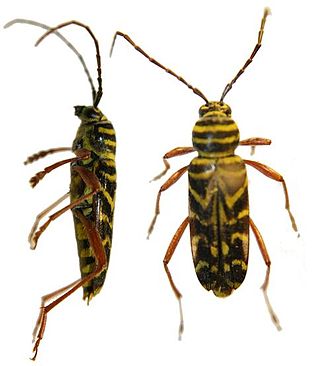
The Fabaceae or Leguminosae, commonly known as the legume, pea, or bean family, are a large and agriculturally important family of flowering plants. It includes trees, shrubs, and perennial or annual herbaceous plants, which are easily recognized by their fruit (legume) and their compound, stipulate leaves. The family is widely distributed, and is the third-largest land plant family in number of species, behind only the Orchidaceae and Asteraceae, with about 765 genera and nearly 20,000 known species.

The honey locust, also known as the thorny locust or thorny honeylocust, is a deciduous tree in the family Fabaceae, native to central North America where it is mostly found in the moist soil of river valleys. Honey locust trees are highly adaptable to different environments, and the species has been introduced worldwide. Outside its natural range it can be an aggressive, damaging invasive species.

Robinia pseudoacacia, commonly known in its native territory as black locust, is a medium-sized hardwood deciduous tree, belonging to the tribe Robinieae of the legume family Fabaceae. It is native to a few small areas of the United States, but it has been widely planted and naturalized elsewhere in temperate North America, Europe, Southern Africa and Asia and is considered an invasive species in some areas, such as the temperate east coast of Australia where the cultivar "Frisia" was widely planted as a street tree before being classed as a weed. Another common name is false acacia, a literal translation of the specific name.

Legumes are plants in the family Fabaceae, or the fruit or seeds of such plants. When used as a dry grain for human consumption, the seeds are also called pulses. Legumes are grown agriculturally, primarily for human consumption, but also as livestock forage and silage, and as soil-enhancing green manure. Well-known legumes include beans, chickpeas, peanuts, lentils, lupins, mesquite, carob, tamarind, alfalfa, and clover. Legumes produce a botanically unique type of fruit – a simple dry fruit that develops from a simple carpel and usually dehisces on two sides.

The carob is a flowering evergreen tree or shrub in the Caesalpinioideae sub-family of the legume family, Fabaceae. It is widely cultivated for its edible fruit, which takes the form of seed pods, and as an ornamental tree in gardens and landscapes. The carob tree is native to the Mediterranean region and the Middle East. Portugal is the largest producer of carob, followed by Italy and Morocco.

Gleditsia is a genus of trees in the family Fabaceae, subfamily Caesalpinioideae, native to the Americas and Asia. The Latin name commemorates Johann Gottlieb Gleditsch, director of the Berlin Botanical Garden, who died in 1786.

Robinia is a genus of flowering plants in the family Fabaceae, tribe Robinieae, native to North America. Commonly known as locusts, they are deciduous trees and shrubs growing 4–25 metres (13–82 ft) tall. The leaves are pinnate with 7–21 oval leaflets. The flowers are white or pink, in usually pendulous racemes. Many species have thorny shoots, and several have sticky hairs on the shoots.
Locusts are the swarming phase of certain species of short-horned grasshoppers in the family Acridida.

Robinia neomexicana, the New Mexican, New Mexico, Southwest, desert, pink, or rose locust, is a shrub or small tree in the subfamily Faboideae of the family Fabaceae.

Prosopis nigra is a South American leguminous tree species that inhabits the Gran Chaco ecoregion, in Argentina and Paraguay. It is known as algarrobo negro in Spanish, which means "black carob tree". It is also variously called algarrobo dulce, algarrobo morado and algarrobo amarillo.
Bean tree is a name used in different parts of the world for various trees that carry their seeds in large pods. Examples include:

Tara spinosa, commonly known as tara (Quechua), also known as Peruvian carob or spiny holdback, is a small leguminous tree or thorny shrub native to Peru. T. spinosa is cultivated as a source of tannins based on a galloylated quinic acid structure. This chemical structure has been confirmed also by LC–MS. It is also grown as an ornamental plant because of its large colorful flowers and pods.

Gleditsia aquatica, commonly called water locust or swamp locust after its habitat of river swamps and slough margins, is a tree native to the Southeastern United States and adjacent regions.

Locust bean gum is a galactomannan vegetable gum extracted from the seeds of the carob tree and used as a thickening agent in food technology.

Gleditsia sinensis, known as zào jiá (皂荚) or Chinese honey locust and black locust in English, is a species of flowering plant native to Asia.

Parkia biglobosa, the African locust bean, is a perennial deciduous tree in the family Fabaceae. It is found in a wide range of environments in Africa and is primarily grown for its pods that contain both a sweet pulp and valuable seeds. Where the tree is grown, the crushing and fermenting of these seeds constitutes an important economic activity. Various parts of the locust bean tree are used for medicinal and food purposes. As a standing tree, locust bean may have a positive effect on the yield of nearby crops.

Megacyllene robiniae, commonly known as the locust borer, is a species of longhorn beetle endemic to eastern North America. It is a serious pest of Robinia pseudoacacia, the black locust tree, with which it is sympatric.
Carob moths are certain species of small snout moths. They are named for their caterpillars' habit of becoming a pest on stored fruits of carob.

Ectomyelois ceratoniae, the locust bean moth, more ambiguously known as "carob moth", is a moth of the family Pyralidae. It has a nearly cosmopolitan distribution.
Algarrobilla, small carob in Spanish, also written algarovilla, may refer to :













